It doesn’t take long for Metroid II to differentiate itself from its predecessor. About… five minutes, I’d guess? That’s about how long it takes, 10 at the outside, for you to encounter your first metroid.
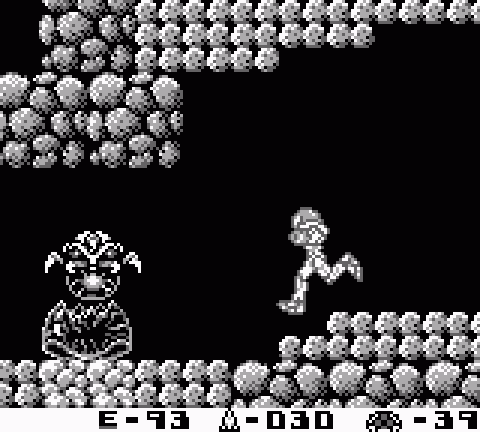
Despite its name, Metroid for NES wasn’t really about metroids. Those creatures only showed up at the very end as an impediment to the real objective, the living supercomputer Mother Brain. Theoretically, you could complete the game without killing a single metroid, whereas both Mother Brain and her guardians Ridley and Kraid had to be taken down.
In Metroid II, however, killing metroids is Samus’ entire purpose. Exterminating the species is so central to the action, in fact, that a third of the status display is entirely given over to indicating precisely how many metroids remain living on planet SR-388. You start at 39 with a goal of working your way down to zero.
The first of the metroids appears very early in the quest, well before Samus has acquired the Ice Beam. So, you’re in trouble, right? Thankfully, no; in their home environment, metroid mutate into new forms, and they leave their jellyfish-like shell behind in order to evolve. You can see that evolution at work here, as the creature that emerges from the first metroid larva you encounter retains the species’ trademark triple eyes and quadruple fangs. But its core drops, becoming a sort of transparent heart. Handily, this is also its weak point — and it turns out that absent their larval shells, metroids needn’t be frozen in order to destroy them. Five missiles, no ice, and this guy is down for the count.
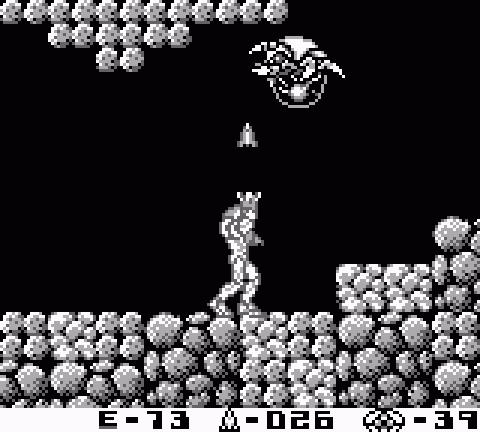
In profile, you can see the first-stage metroid (designated an alpha metroid) is like some sort of weird crustacean floating around with a giant belly attached to it. Doesn’t really seem a practical approach to physiology, but what do I know? I’m no xenobiologist.
Alpha metroids are considerably less threatening than their pupal counterparts. Not only do they no longer need to be frozen, they also move more slowly and much less aggressively. The only real challenge here is that they recoil from missile impacts, so you can’t just pour on the destruction — you need to re-aim after every action.
This search-and-destroy design makes Metroid II the most straightforward of the core Metroid titles. You have one goal: Eradicate every metroid.
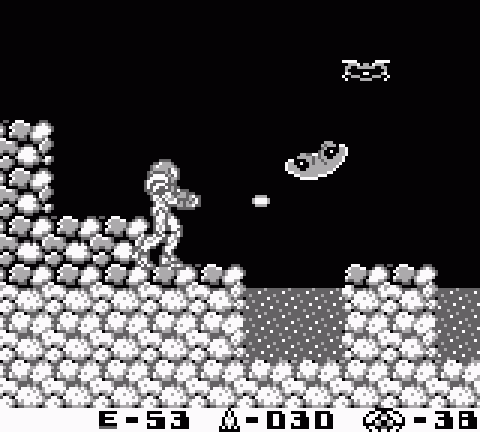
The linearity doesn’t simply stem from the mission structure, though; the world design also turns out to be far more straightforward than in other Metroid games. The main path through SR-388 takes the form of a central passage flooded by acidic fluid, connected to isolated pockets of caverns that branch away from the main route. Once you defeat all the metroids in a given pocket, an earthquake will cause the fluid levels to change, exposing the way to the next area. The only other game in the series with a slightly similar design philosophy was Metroid Fusion, which deliberately referenced Metroid II, and even there you could find a number of passages and shortcuts linking the isolated regions of the space station.
You experience Metroid II‘s first quake after defeating the lone, newly molted metroid found in the cavern to the left of the entrance to the planet’s underground areas. Once the shaking comes to a halt, the liquid that blocked the shaft to the right settles further down and allows you access to your first main area of the game. Although it’s not designated as such, you could think of this as the game’s first level.
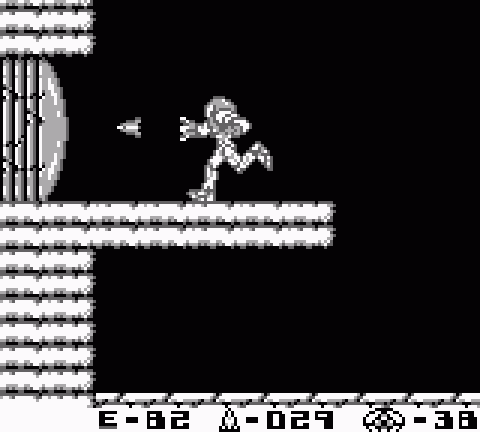
I said that Samus’ possession of missiles right from the start precludes the use of “missile doors” as an impediment, but that doesn’t mean they don’t exist in the game. This time, however, the highly resistant doors aren’t meant to frustrate you in the early portions of the game and force you to return to explore them once you’ve located a missile. Instead, their presence serves as an indicator: There’s something valuable back here. Unless I’m forgetting something, missile doors exist only at the entrance to power-up chambers. So if you see one of these, you know there’s something good on the other side.
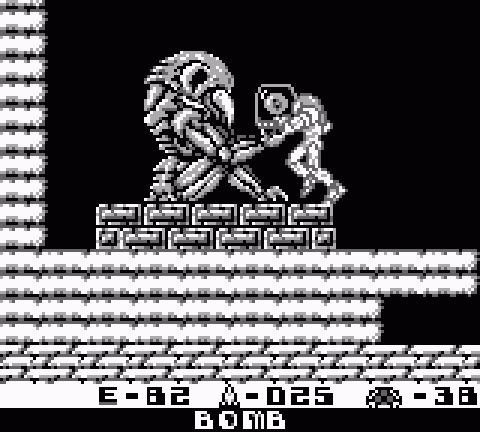
In this case, the first missile door you’ll come across contains the Bomb.
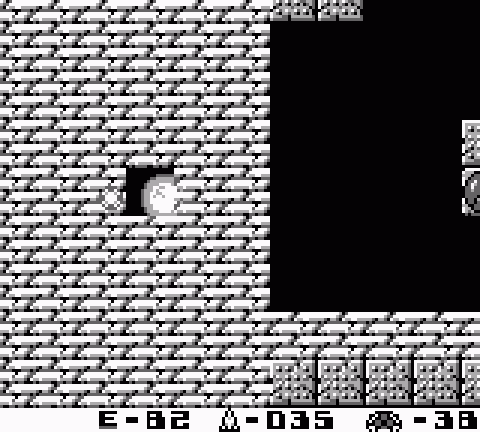
You need a Bomb to clear an obstructive block in a wall, which works exactly like it did in Metroid and lets you open the path to your next target. This is still really early in the game, but now that you have the ability to drop Bombs there’s no cause for backtracking. None of the handful of areas you’ve encountered before this moment had bombable bricks hiding secrets; in fact, Metroid II deprecates the entire concept of backtracking. For the most part, the only time you’ll ever really need to retrace your steps is to return to the central path once you’ve caused a quake.
As such, there’s no reason for the Bomb to have been handed out like this; it could just as easily have served the same role in the game had Samus possessed it from the start, as she did with other Metroid powers like the Long Beam, the Maru Mari, and the 30 missiles she kicks off with. But she doesn’t, and collecting it like this gives a sense of empowerment to the player. It’s little more than lip service to the concept of becoming stronger, since the block you have to break here is the first time you’ve encountered an impediment like this, and the Bomb is located immediately adjacent. But there’s something to be said for allowing the player to feel like they’re making progress.
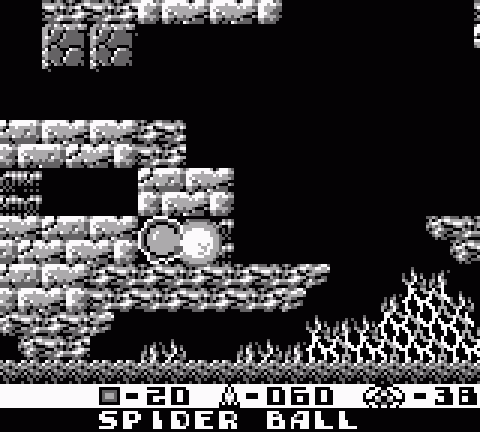
Curiously enough, there’s a second power-up located in this section, too: The Spider Ball. Not 15 minutes into the adventure — chances are you’ve only killed the one metroid so far! — and already you’ve found two key skill upgrades.
The Spider Ball works like nothing you found in Metroid. By double-tapping into a ball, you can cause Samus to cling to any and every surface in the game — save those covered with spikes — which greatly improves your range of exploration. In fact, the only thing that can prevent you from accessing an area once you acquire the Spider Ball are deliberate obstacles, like acid pools and wall protrusions that cause damage. You’re barely into the game and already you have the ability to go practically anywhere you like. This is a pretty strange way to parcel out character empowerment for a game like this — normally such powerful upgrades are doled out only toward the end, once you’ve been teased and taunted at length by environmental puzzles. Here, you gain a powerful traversal tool right at the beginning.
The upshot is that you can go where you like you like; the downside is that the latter half of the adventure feels pretty flat, because there’s not too much more you can do to enhance Samus’ power. Also, I’m not a huge fan of the Spider Ball in general, as rolling along every surface of the game at half-speed in search of passages is pretty dull. It’s an interesting concept for a skill, and the designers were incredibly bold to hand it out so early, but it needed a little more time in the oven, I think.
Just wondering, do you think the Spider-ball was better executed in the Metroid Prime games?
The Spider Ball hasn’t ever really made a return, and that’s probably for a reason. Metroid II was my first Metroid game, borrowed from a friend and played in the back of a van during a six hour drive to summer camp. I enjoyed it a lot when I first played it, but even then I found it odd how much of the game was spent rolling around the environment slowly. Imagine my relief at getting a hold of Metroid and later Super Metroid and seeing a complete lack of upside-down rolling ball traversal.
The Spider Ball was less tiresome in Metroid Prime, but it’s also symptomatic of the series’ move away from feeling like you’re making natural progress and toward everything feeling like an elaborate puzzle. Wasn’t it convenient of the bird people who made these ancient temples to put Spider Ball strips just where Samus would need them!
Samus’s motivation in this game always confused me. She goes to this poor creature’s home planet and proceeds to start systematically killing them one by one. Even hand-waving the poorly explained reasoning for her genocidal impulses, why doesn’t she just blow up the planet right from the start? Is it that important that she scrounge around for a few missile upgrades first?
@jpfriction SR-388 Didn’t get blown up until Metroid Fusion. Metroid II is actually the one game in the series that doesn’t end with something blowing up.
This is slightly off-topic, but I’m curious about the use of “metroid” in lowercase throughout the article. Things like this are something I’ve long been conflicted about how to approach properly.
I mean, I get it: We say “cats”, not “Cats”, “humans”, not “Humans”, and so forth for creatures and species and the like. So saying “metroid” and not “Metroid” or “reploid” (from Mega Man, if anyone reading this is unfamiliar) and not “Reploid” makes sense to me.
At the same time, though, the official sources from which these two fictional terms have come use capitalization. I just checked the manuals for Metroid, Zero Mission, Return of Samus, Super Metroid, and Other M to see how they did it, and each refers to the creature as a “Metroid”, not a “metroid”.
Of further interest was the decision to use “Bomb” instead of “bomb”.
I’m not trying to nitpick; as I said before, this is something I’ve seen in other instances, and I’m really curious what the “correct” way to approach it is, when the creator of an idea uses it as a name, despite common conventions outside of their franchises.
@LBD “Nytetrayn” (1) Makes it easier to distinguish between title of the game and the name of the creature (2) it’s standard copy edit style.
The spider ball is neat in concept, but in execution it’s way too slow, especially with how big rooms will get.
Also, just because Metroid II is linear doesn’t mean it’s not open within its linear constraints. Some of the later metroid hunting grounds cover a wide, often very confusing range of ground where the challenge is finding the metroids in the first place.
I think Yoshio Sakimoto once said that Metroid is supposed to mean “one who runs through metro-like tunnels” like what comprised planet Zebes, so the term metroid actually applies best to Samus.
Not quite. “Metroid” is a portmanteau of “metro” (as in subway) and “android.”
Ah, yes! Metro and android apply even more to Samus!
This pertains more to the previous entry regarding Samus height, but how high are the jumps in Metroid 2? I recall Zero Mission and maybe Fusion having pretty short jumps to compensate for the short screen.
A weird aside about Metroid II, I played it on one of the emulators for GBA, and it had a feature to force drawing of stuff into the left and right sides of the screen. If memory serves me correctly it only showed the background.Iit gave the game a very interesting feel. A lot less cramped, but since you didn’t see monsters until they were in normal Game Boy range there was still some urgency. Like using sonar that catches the walls but it’s still dark so monsters have to be closer with light amplification.
I wouldn’t be surprised if they had you acquire the bomb (instead of starting with it) so that you’d discover the ability to shoot downwards in the first section of the game, instead of you stumbling upon the ability by accident later on.
Good point!
Samus’ motivation quite simply is financial reward. . .she is a Bounty Hunter after all I love how the earthquakes signify a change in the environment, I can’t remember a game doing that kind of thing before this. Also, as she is tasked with eradicating an entire species, would you say that this is the first time genocide is the purpose in a videogame?
I love how the earthquakes signify a change in the environment, I can’t remember a game doing that kind of thing before this. Also, as she is tasked with eradicating an entire species, would you say that this is the first time genocide is the purpose in a videogame?
I actually bombed my way over a huge cliff and got the Spider Ball backwards-an incredible feat. I had no idea that the walls could have hidden passageways. It took me about an hour and the whole time I was thinking how bad the level design was.
Chicago Frank: Nintendo/Sakamoto would argue that point with you. ;P
About doing it for financial gain, I mean. She apparently does all this for free.
I assume you’re going to discuss the music of the series in more details in another post, but I remember the encounter with the first metroid terrifying me as a kid and I think part of it was the music.
You start of this game with this nice heroic sounding piece that gets you excited about exploring this underground cavern, until you run into your first metroid and the music changes to a stinger that wouldn’t feel out of place in a slasher film. It’s very jarring, and as a kid who shied away from horror films I found it very scary.
I feel the whole soundtrack of Metroid II gets unfairly dumped on by a lot of fan, but I’m guess that’s a point you’ll address later in this series.